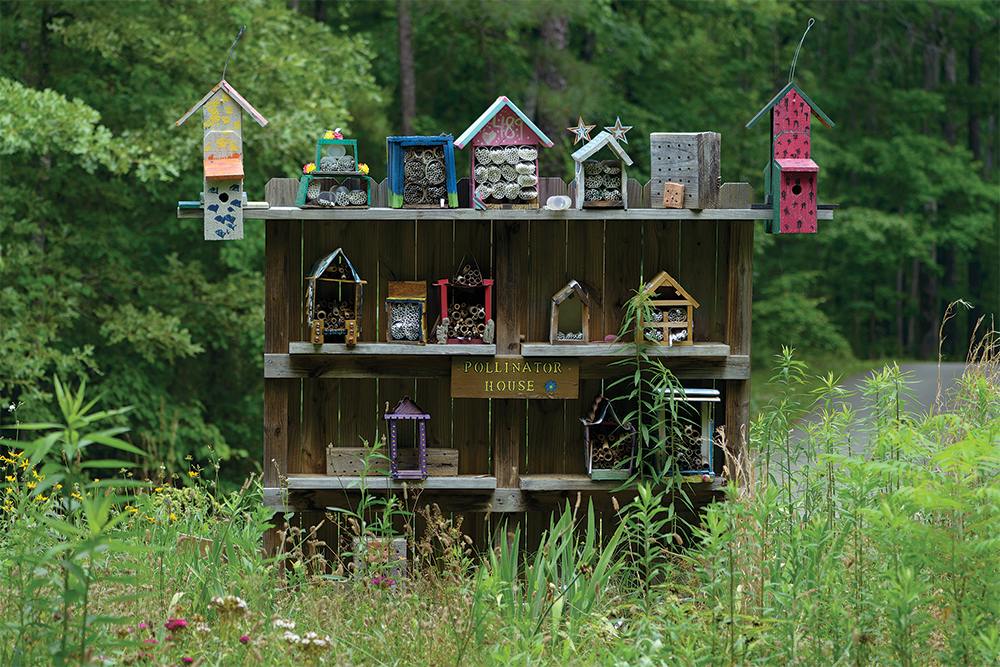By Katie Jackson

Many of us work hard to make pollinators feel at home in our landscapes, but there’s always more we can do for these and other beneficial insects, such as providing them with dream homes.
Though a number of animal species, including birds, bats, small mammals and reptiles, assist in pollination services, insects do the yeoman’s work, and it’s bees that provide the most bang for the buzz by pollinating 80 percent of the world’s plants and at least 90 percent of the world’s food crops.
While honey and bumblebees are the best-known pollinators, lesser-known native solitary bees such as orchard mason, leafcutter, blueberry and squash bees are also vital. In fact, solitary bees, which make up 90 percent of the almost 4,000 bee species in the United States, don’t just help with pollination. They are fundamental links in the food chain and essential to ecosystem balance and biodiversity.
Despite their importance to us, these solitary bees and their solitary wasp cousins are often overlooked and underappreciated. That may be because, unlike their very social honey and bumblebee relatives (bees and wasps both belong to the order Hymenoptera), solitary bees and wasps live independent of one another rather than in hives and colonies. Since they usually nest in out-of-the-way places, such as tunnels beneath the soil, crevices between rocks and inside hollow plant stems, we may never know they’re around—until they aren’t.
Ensuring they come around is relatively easy if we provide reliable sources of food and water, access to lots of native plants and protection from chemical pesticides. To keep them around, however, we need to offer suitable housing.
When it comes to housing, solitary bees and many other beneficial insects are perfectly content with humble abodes such as brush piles, piles of rocks or bricks, bundles of stems and, in the case of ground-dwelling insects, areas of bare, loose soil. In other words, leave areas of the landscape naturalized—maybe even a little messy—and they’ll be happy homemakers.
However, some also enjoy something a little more upscale, such the exquisite pollinator houses (also called pollinator or bee hotels) that you may have noticed popping up in public and private landscapes. These houses offer a variety of room designs (nesting cavities) that appeal to solitary bees. Lucky for us, this collection of rooms involves a blend of shapes, sizes and materials that become appealing works of art, and they can be created using a range of found, recycled and upcycled items.
Though pollinator houses should meet a few basic building and maintenance codes (see list below) to be effective, they offer us a chance to be creative, as proved by a group of University of Alabama Birmingham art students who, in 2017, designed and built amazing insect houses for the Ruffner Mountain Reserve in Birmingham. These houses and others like them are not only stunning, they are exceptional educational tools and can be great DIY projects for families or for community groups.
If you want to learn more about insect dream homes, check out expert sources such as the Xerces Society (https://xerces.org) or at local public gardens, garden stores and community gardening organizations.
Pollinator House Building Codes:
Use the following basic guidelines to make a home for solitary bees and wasps as well as other beneficial insects. House plans and additional details are available from many sources including in an article written by Ruffner Mountain’s native habitat director Michelle Reynolds (www.diynetwork.com/how-to/outdoors/gardening/build-a-backyard-bee-house).
• Provide a diverse selection of nesting cavities and materials.
• Frame and roof the house to protect residents from the elements.
• Locate the house on an open site, preferably south- to southeast-facing, where no vegetation obscures the cavity entrances.
• Erect the house three to four feet off the ground and anchor it securely against winds.
• Clean the house annually and replace nesting materials every two years.
March Tips
- Celebrate the first day of spring (March 19) by doing something in the garden.
- Get gardening tools and equipment ready for the year.
- Add compost, manure and other organic materials to garden beds.
- Begin planting spring crops such as snow peas, cauliflower, celery, onion and radishes.
- Plant strawberries, blueberries, grapes and fruit trees.
- Begin fertilizing houseplants.
- Remove weeds from gardens beds as soon as they emerge.




